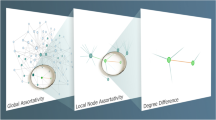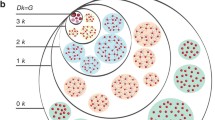Abstract
The high-level contribution of this paper is a quantitative measure (called Randomness Index) to assess the extent of randomness in the topology of a complex real-world network. We exploit the observation that the local clustering coefficient (LCC) for a node in a truly random network is independent of the degree of the node and is simply the probability for a link to exist between any two nodes in the network. On the other hand, for real-world networks that are not truly random, nodes with a larger degree are more likely to have a lower LCC value and vice versa. For any complex real-world network, we propose to determine the Randomness Index as the Pearson’s correlation coefficient (ranging from −1 to 1) of the degree versus average LCC of the nodes with the particular degree. We evaluate the Randomness Index values for a suite of 48 real-world networks of diverse degree distribution and observe the median value to be −0.72.












Similar content being viewed by others
References
Al-Shiridah G, Mahdi K, Safar M (2013) Feedback capacity of different complex network models. In: Proceedings of the 27th international conference on advanced information networking and applications workshops. Barcelona, pp 996–1003
Barabasi AL (2016) Network science, 1st edn. Cambridge University Press, Cambridge
Barabasi AL, Albert R (1999) Emergence of scaling in random networks. Science 286(5439):509–512
Batagelj V, Mrvar A (2006) Pajek datasets. http://vlado.fmf.uni-lj.si/pub/networks/data/
Bernard HR, Killworth PD, Sailer L (1980) Informant accuracy in social network data IV: a comparison of clique-level structure in behavioral and cognitive network data. Soc Netw 2(3):191–218
Biedl T, Franz BJ (2001) Graph-drawing contest report. In: Proceedings of the 9th international symposium on graph drawing. pp 513–521
Bloznelis M (2013) Degree and clustering coefficient in sparse random intersection graphs. Ann Appl Probab 23(3):1254–1289
Bonacich P (1987) Power and centrality: a family of measures. Am J Sociol 92(5):1170–1182
Britton T, Deijfen M, Martin-Lof A (2006) Generating Simple random graphs with prescribed degree distribution. J Stat Phys 124(6):1377–1397
Cross RL, Parker A, Cross R (2004) The hidden power of social networks: understanding how work really gets done in organizations, 1st edn. Harvard Business Review Press, Cambridge
de Nooy W (1999) A literary playground: literary criticism and balance theory. Poetics 26(5–6):385–404
Erdos P, Renyi A (1959) On random graphs I. Publ Math 6:290–297
Evans JD (1995) Straight forward Statistics for the behavioral sciences, 1st edn. Brooks Cole Publishing Company, Pacific Grove
Foudalis I, Jain K, Papadimitriou C, Sideri M (2011) Modeling social networks through user background and behavior. In: Proceedings of the 8th international conference on algorithms and models for the web graph. Atlanta, pp 85–102
Freeman LC, Freeman SC, Michaelson AG (1989) How humans see social groups: a test of the Sailer–Gaulin models. J Quant Anthropol 1:229–238
Freeman LC, Webster CM, Kirke DM (1998) Exploring social structure using dynamic three-dimensional color images. Soc Netw 20(2):109–118
Geiser P, Danon L (2003) Community structure in jazz. Adv Complex Syst 6(4):563–573
Gemmetto V, Barrat A, Cattuto C (2014) Mitigation of infectious disease at school: targeted class closure vs. school closure. BMC Infect Dis 14(695):1–10
Gil-Mendieta J, Schmidt S (1996) The political network in Mexico. Soc Netw 18(4):355–381
Girvan M, Newman MEJ (2002) Community structure in social and biological networks. Proc Natl Acad Sci USA 99(12):7821–7826
Gleiser PM (2007) How to become a superhero. J Stat Mech Theory Exp 2007:P09020
Godehardt E, Jaworski J (2001) Two models of random intersection graphs and their applications. Electron Notes Discrete Math 104:129–132
Grimmer J (2010) A Bayesian hierarchical topic mode for political texts: measuring expressed agendas in Senate press releases. Political Anal 18(1):1–35
Hayes B (2006) Connecting the dots. Am Sci 94(5):400–404
Hummon NP, Doreian P, Freeman LC (1990) Analyzing the structure of the centrality-productivity literature created between 1948 and 1979. Sci Commun 11(4):459–480. doi:10.1177/107554709001100405
Humphries MD, Gurney K (2008) Network ‘small-world-ness’: a quantitative method for determining canonical network equivalence. PLoS ONE 3(4):e0002051
Isella L, Stehle J, Barrat A, Cattuto C, Pinton JF, Van den Broeck W (2011) What’s in a crowd? Analysis of face-to-face behavioral networks. J Theor Biol 271(1):166–180. doi:10.1016/j.jtbi.2010.11.033
Knuth DE (1993) The Stanford GraphBase: a platform for combinatorial computing, 1st edn. Addison-Wesley, Reading
Krackhardt D (1999) The ties that torture: Simmelian tie analysis in organizations. Res Sociol Organ 16:183–210
Krebs V (2003) Proxy networks: analyzing One network to reveal another. Bull Méthodol Sociol 79:61–70
Lee J-S (2004) Generating networks of illegal drug users using large samples of partial ego-network data. In: Intelligence and security informatics (Lecture nodes in computer science), vol 3073. pp 390–402
Li M, O’Riordan C (2013) The Effect of clustering coefficient and node degree on the robustness of cooperation. In: Proceedings of the 2013 IEEE congress on evolutionary computation. Cancun, pp 2833–2839
Loomis CP, Morales JO, Clifford RA, Leonard OE (1953) Turrialba social systems and the introduction of change. The Free Press, Glencoe, pp 45–78
Lusseau D, Schneider K, Boisseau OJ, Haase P, Slooten E, Dawson SM (2003) The bottlenose dolphin community of Doubtful Sound features a large proportion of long-lasting associations. Behav Ecol Sociobiol 54(3):396–405
MacRae D (1960) Direct factor analysis of sociometric data. Sociometry 23(4):360–371
C. McCarty and L. Freeman, http://moreno.ss.uci.edu/data.html, 2008
Meghanathan N (2014) Spectral radius as a measure of variation in node degree for complex network graphs. In: Proceedings of the 3rd international conference on digital contents and applications. Hainan, pp 30–33
Meghanathan N (2015) Distribution of maximal clique size of the vertices for theoretical small-world networks and real-world networks. Int J Comput Netw Commun 7(4):21–41
Meghanathan N (2016) On the sufficiency of using the degree sequence of the vertices to generate random networks corresponding to real-world networks. Polibits Res J Comput Sci Comput Eng Appl 53:5–21
Meghanathan N (2017a) A computationally-lightweight and localized centrality metric in lieu of betweenness centrality for complex network analysis. Springer Vietnam J Comput Sci 4(1):23–38
Meghanathan N (2017b) Complex network analysis of the contiguous United States graph. Comput Inf Sci 10(1):54–76
Michael JH (1997) Labor dispute reconciliation in a forest products manufacturing facility. For Prod J 47(11–12):41–45
Moreno JL (1960) The sociometry reader. The Free Press, Glencoe, pp 534–547
Nepusz T, Petroczi A, Negyessy L, Bazso F (2008) Fuzzy communities and the concept of bridgeness in complex networks. Phys Rev E 77(1):016107
Newman MEJ (2002) Assortative mixing in networks. Phys Rev Lett 89(20):208701
Newman MEJ (2010) Networks: an introduction, 1st edn. Oxford University Press, Oxford
Newman MEJ (2006) Finding community structure in networks using the eigenvectors of matrices. Phys Rev E 74(3):036104
Pearson M, Michell L (2000) Smoke rings: social network analysis of friendship groups, smoking and drug-taking. Drugs Educ Prev Policy 7(1):21–37
Pizzuti C, Rombo SE (2014) Algorithms and tools for protein-protein interaction networks clustering, with a special focus on population-based stochastic methods. Bioinformatics 30(10):1343–1352
Ravasz L, Barabasi AL (2003) Hierarchical organization in complex networks. Phys Rev E 67:026112
Resnick MD, Bearman PS, Blum RW, Bauman KE, Harris KM, Jones J, Tabor J, Beuhring T, Sieving RE, Shew M, Ireland M, Bearinger LH, Udry JR (1997) Protecting adolescents from harm. Findings from the National Longitudinal Study on Adolescent Health. J Am Med Assoc 278(10):823–832
Rogers EM, Kincaid DL (1980) Communication networks: toward a new paradigm for research. Free Press, New York
Schwimmer E (1973) Exchange in the social structure of the Orokaiva: traditional and emergent ideologies in the Northern District of Papua. C Hurst and Co-Publishers Ltd., London
Scott JP (1980) The anatomy of Scottish capital: Scottish companies and Scottish capital, 1st edn. Brooks Cole Publishing Company, Pacific Grove, pp 1900–1979
Smith DA, White DR (1992) Structure and dynamics of the global economy: network Analysis of international trade 1965–1980. Soc Forces 70(4):857–893
Soffer SN, Vazquez A (2005) Clustering coefficient without degree correlations biases. Phys Rev 7:057101
Strang G (2006) Linear algebra and its applications, 4th edn. Brooks Cole, Pacific Grove
Takahata Y (1991) Diachronic changes in the dominance relations of adult female Japanese monkeys of the Arashiyama B group. In: Fedigan LM, Asquith PJ (eds) The monkeys of Arashiyama. State University of New York Press, Albany, pp 124–139
Ugarte MD, Militino AF, Arnholt AT (2015) Probability and statistics with R, 2nd edn. Chapman and Hall, Boca Raton
Watts DJ, Strogatz SH (1998) Collective dynamics of ‘small-world’ networks. Nature 393:440–442
White JG, Southgate E, Thomson JN, Brenner S (1986) The structure of the nervous system of the nematode Caenorhabditis elegans. Philos Trans B 314(1165):1–340
Zachary WW (1977) An information flow model for conflict and fission in small groups. J Anthropol Res 33(4):452–473
Author information
Authors and Affiliations
Corresponding author
Rights and permissions
About this article
Cite this article
Meghanathan, N. Randomness Index for complex network analysis. Soc. Netw. Anal. Min. 7, 25 (2017). https://doi.org/10.1007/s13278-017-0444-3
Received:
Revised:
Accepted:
Published:
DOI: https://doi.org/10.1007/s13278-017-0444-3




